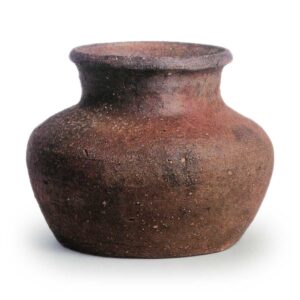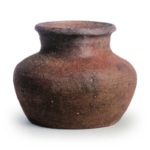
14th century
Height 12.7cm, mouth diameter 10.4cm, body diameter 17.1cm, bottom diameter 12.4cm
Tokoname Municipal Institute of Ceramic Art
This type of wide-bottomed, flat-bodied small jar is rare and scarce in Tokoname. Judging from its form and firing, it probably belongs to the Nanboku-cho period. Although this small jar lacks tobiguchi-style processing on the mouth rim, it is undoubtedly the ancestor of the later kataguchi-style oil jars. From the Nanbokucho period to the Muromachi period (1336-1573), Echizen and Bizen produced a large number of kataguchi-kotsujars as oil jars, while examples from Tokoname are scarce, probably because ash- and iron-glazed kataguchi-kotsujars were mass produced in Seto, which played a part in the division of labor in this region. Therefore, the lack of kataguchi on this piece may be due to the fact that it was used for other purposes. The reddish-brown surface is covered with a natural glaze.








